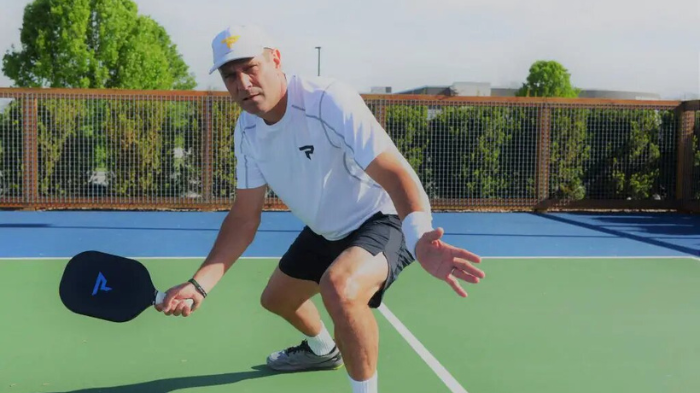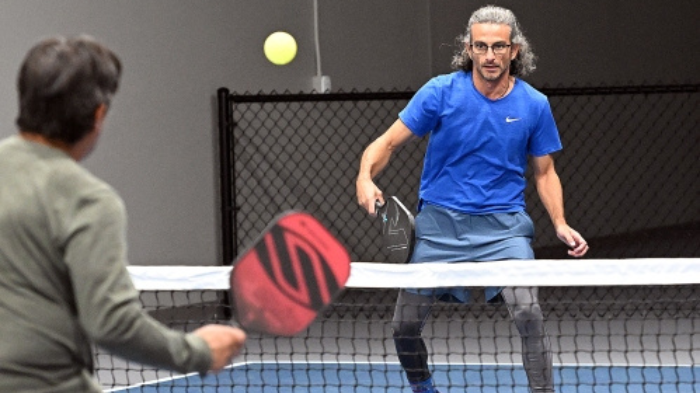Can you switch hands in pickleball? This is a common question that often arises in the minds of pickleball players when they want to enhance their game and explore various techniques. In this blog post, we are going to discuss whether you can switch hands in pickleball or not and the official rules regarding pickleball switching hands.
We are also going to explain why players opt for switching hands in pickleball, when and how to switch your hands in pickleball, benefits and drawbacks of pickleball switching hands, and the common mistakes to avoid when switching hands in this game.
Is It Ok to Switch Hands in Pickleball
Yes, in pickleball, it is generally acceptable to switch hands. Pickleball has gained recognition for its remarkable adaptability, empowering players to tailor their playing styles to suit their individual preferences. Although it is more prevalent to maintain the dominant hand, there are instances where switching hands can provide distinct advantages.

For example, if a player has a stronger backhand shot with their non-dominant hand, they might choose to switch hands to make that shot. Similarly, if a player’s dominant hand is fatigued or injured, they might switch hands temporarily to continue playing. Some players may also switch hands during less competitive matches or recreational play for fun or to challenge themselves.
However, it is important to note that switching hands in pickleball can present challenges and potentially impact your overall performance, especially if you are not accustomed to utilizing your non-dominant hand. Developing proficiency with your non-dominant hand requires dedicated practice and time investment.
Ultimately, whether or not you can switch hands in pickleball depends on the rules and regulations of the specific game or tournament you’re playing in. It is always best to check with the organizers or refer to the official rules to ensure you are playing within the designated guidelines.
Official Rules Regarding Hand Switching in Pickleball
The United States of America Pickleball Association (USAPA) has set forth official rules pertaining to hand-switching in pickleball. Here is a summary of those rules:
- Players are permitted to switch hands during a rally if they initially hold the paddle in their non-dominant hand.
- Once a player decides to switch hands in pickleball during a rally, they must stick with their new dominant hand for the rest of that rally.
- If a player starts a rally with the paddle in their dominant hand, they are not allowed to switch hands during that particular rally.
- Players are not allowed to switch hands to avoid hitting a ball that is on their dominant side.
- If a player accidentally touches the net with their paddle while switching hands, they will lose the point.
- Dropping the paddle while switching hands in pickleball also results in losing the point.
Please note that it is always advisable to refer to the official rulebook of the USAPA or consult with tournament organizers for the most up-to-date and detailed rules regarding hand-switching in pickleball.
Why You Should Switch Hands in a Pickleball Game?
Some players opt to switch hands during a pickleball game as a strategic move to gain an advantage or enhance their shot selection. Here are a few reasons why players make this choice:
Backhand Weakness: Switching hands in pickleball lets players use their stronger hand for backhand shots. This is helpful when their backhand is weaker compared to their forehand. By switching hands, they can hit stronger and more accurate shots using their dominant hand when playing on the backhand side.
Better Reach: Pickleball involves a lot of lateral movement, and sometimes players find it difficult to reach shots on their non-dominant side. Switching hands in pickleball enables players to adjust their positioning so that their dominant hand is closer to the ball, thereby improving their reach and control.
Strategic Placement: Switching hands in pickleball allows players to strategically position their shots. For example, when a player switches hands to utilize their dominant hand for forehand shots, they can enhance their shot power and precision. This allows them to hit the ball at a greater distance into their opponent’s court or aim for specific target areas with greater ease.
Surprise Element: Switching hands during a game can be a strategic surprise tactic that catches opponents off guard, making it difficult for them to predict the player’s shot direction or type. This element of surprise frequently results in opponents making mistakes and creates advantageous opportunities for the player to capitalize on, secure winning points, and gain a competitive edge in the game.
How to Switch Your Hands in Pickleball?
Here’s a step-by-step guide on how to switch hands in pickleball:
Determine Your Dominant Hand: To begin the process of switching your hands in pickleball, the first step is to determine your dominant hand, for example, your right hand.
Prepare For The Switch: To switch your hands in pickleball, start by positioning your dominant hand (right hand) on the paddle. Then, use your non-dominant hand (left hand) to support the bottom of the paddle handle.

Choose The Appropriate Moment: Stay attentive and remain focused on the game, carefully selecting the right moment to switch hands. Opt for a suitable time, such as during a break in the game or when the ball is not moving.
Release Your Dominant Hand: Release your hold on the paddle with your dominant hand (right hand). Relax your fingers and let the paddle rest against your non-dominant hand (left hand) while keeping your grip on the handle.
Rotate The Paddle: While securely holding the paddle handle with your non-dominant hand (left hand), rotate the paddle in your hand until you have successfully positioned the front side of the paddle to face the opposite direction. This rotational motion resembles flipping the paddle in your non-dominant hand, resulting in a change of its orientation.
Regrip With Your Dominant Hand: Once you have rotated the paddle, extend your dominant hand (right hand) and securely grip the handle by stretching it from the opposite side of your body. Make sure to adjust your grip until you feel comfortable and confident in how securely you are holding the paddle handle. Now, your dominant hand will have a firm grasp on the handle.
Adjust Your Non-Dominant Hand: Slide your non-dominant hand (left hand) upwards along the paddle handle, moving it closer to the face of the paddle. This adjusted hand position will now serve as your hitting hand for striking the ball.
Continue Playing: After successfully switching hands and obtaining a secure grip, you are ready to continue playing pickleball. Your non-dominant hand (left hand) will now serve as your hitting hand, while your dominant hand (right hand) will provide support and stability throughout the game.
Remember, it may take some practice to become comfortable with switching hands in pickleball. Start with slow movements and gradually increase your speed as you become more proficient. Consistent practice will assist you in building the coordination and muscle memory necessary to execute a seamless hand switch during the game.
When to Switch Your Hands While Playing Pickleball?
There are a few suitable moments to consider switching your hands while playing pickleball:
Between Points: Take advantage of the brief pause between points to switch your hands. This is a common time to make the switch since there is usually a break in the action.
During A Timeout: If you or your team calls a timeout, it provides an ideal opportunity to switch your hands in pickleball. During these intervals, take advantage of the break in the game to adjust your grip on the paddle and switch your hitting hand if necessary or desired.
When The Ball Is Not In Play: Look for moments when the ball is not in motion or when there is a break in the game. This could occur when waiting for a serve, when the ball is being retrieved, or during a non-engaging rally.
Remember, the timing of hand switches in pickleball may vary depending on individual preferences, playing style, and specific game situations. It is essential to practice and find the most comfortable and seamless moments for you to switch hands while maintaining game flow.
Pros and Cons of Switching Hands in Pickleball
Switching hands in pickleball can have both pros and cons. Let’s explore them:
Pros:
- Improved Reach And Control: Switching hands allows you to access different angles and positions on the court more effectively, enabling better reach and control over shots.
- Enhanced Shot Versatility: By using your non-dominant hand as your hitting hand, you can execute a wider range of shots, including backhands and volleys, with greater ease and accuracy.
- Balanced Muscle Development: Switching hands helps to develop coordination and strength in both hands, promoting balanced muscle development and reducing the risk of overuse injuries.

Cons:
- Adjustment Period: In the beginning, switching hands may feel unfamiliar and take some time to adjust. It requires practice to develop a sense of comfort and coordination when using your non-dominant hand as the hitting hand.
- Decreased Power: Due to the non-dominant hand potentially lacking the same strength and natural coordination as the dominant hand, you may experience a slight decrease in power when hitting the ball with your non-dominant hand.
- Potential For Errors: During the transition of switching hands, there is a possibility of making mistakes, such as mishits or misjudging the ball, until you become fully proficient with the hand switch technique.
Common Mistakes to Avoid When Switching Hands in Pickleball
When you switch hands in pickleball, it is essential to stay mindful of common mistakes and try to avoid them. Here are a few typical mistakes to be cautious of:
Incomplete Hand Switch: Ensure that you fully rotate the paddle and reposition your hands during the switch. Failing to complete the hand switch can lead to improper grip and compromised shot execution.
Grip Adjustment Issues: Take the time to properly adjust your grip after switching hands. Neglecting to do so may result in an uncomfortable grip or a lack of control over the paddle, affecting your shots.
Timing Errors: Choose the right moments to switch hands. Avoid switching hands when the ball is in play or during critical moments, as it can disrupt your timing and potentially lead to errors or missed shots.
Lack Of Practice: Switching hands requires practice to develop coordination and muscle memory. Not dedicating enough practice time to switching hands can hinder your ability to execute the technique effectively during a game.
Over-Reliance On The Dominant Hand: Resist the temptation to rely solely on your dominant hand for shots, even after switching hands. Put in a deliberate effort to develop the capabilities of your both hands to ensure maximum performance in the game.
FAQs
Yes, it is legal and permitted to switch hands in pickleball as long as you comply with the rules and ensure that it does not disrupt the game’s flow.
Yes, switching hands in pickleball can help to improve your backhand shots by allowing you to utilize your non-dominant hand for better control and execution.
The time it takes to become accustomed to switching hands in pickleball varies for each individual. It depends on factors such as your existing hand coordination, playing experience, and practice consistency. Generally, it takes several weeks to a few months of practicing regularly to develop the coordination and confidence required to perform smooth hand switches. Consistent and dedicated practice is crucial for becoming comfortable and proficient in this technique.
Yes, it is crucial to modify your grip when switching hands to have a comfortable and secure hold on the paddle. This adjustment ensures that you can execute shots optimally with precision and control.
Conclusion
“Can you switch hands in pickleball?” Yes, you can switch your hands in pickleball. By doing so, you can experience improved reach, better shot control, enhanced shot versatility, decreased risk of overuse injuries, etc. By familiarizing yourself with the process of switching hands in pickleball and knowing the opportune moments to do so during gameplay, you can effectively integrate hand switches into your pickleball strategy.
Switching hands in pickleball has certain limitations, including a potential decrease in power, an increased likelihood of mistakes, a sense of unfamiliarity when attempting to switch hands for the first time, and requiring additional time for adjustment. After writing this blog, we suggest you to practice switching your hands in pickleball without making any common mistakes and elevate your pickleball playing skills.



